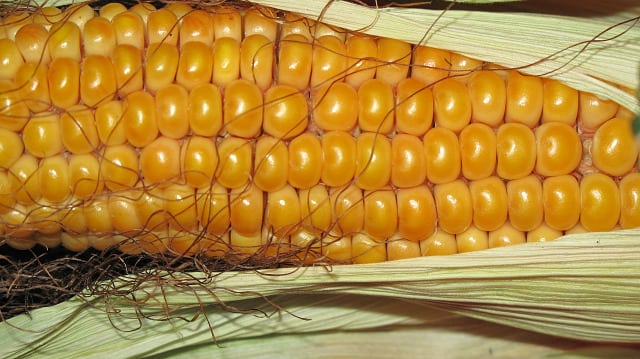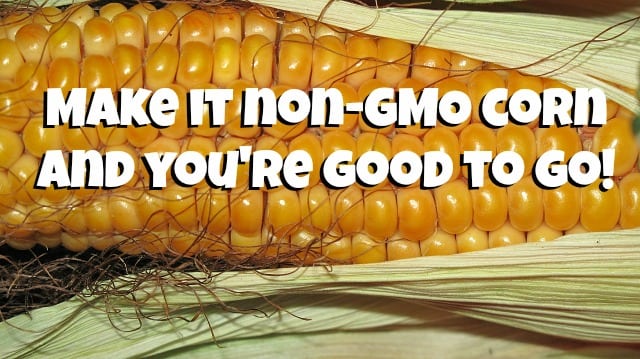Many of us avoid corn in pet food because we’ve heard that it’s bad for cats and dogs. Corn has a reputation for being an allergen, indigestible and an unnecessary filler. With a reputation like this, it makes sense to banish it from our pet’s bowls. But a recent article from the American Animal Hospital Association does a good job at turning corn’s reputation upside down.
Vet Experts Say Corn in Pet Food is Nutritionally Sound

In the January 2017 AAHA-newsletter article “Myth Busters: Corn Edition!” veterinary nutritionists speak out against corn’s bad reputation. The article tackles popular myths about corn in pet food, such as:
Myth #1: Dogs and cats did not evolve eating grains and therefore cannot digest grains.
Myth #2: Grains are allergenic.
Myth #3: One can evaluate the ‘quality’ of a pet food by reading the ingredient list.
Myth #4: Corn/grains are non-nutritive ‘fillers.’
If you’re a skeptic and thinking that experts in the article work for the major commercial pet food companies (we did at first), think again. Unlike previous pet food industry-sponsored information about corn, most of pet nutrition experts quoted are from institutions with no clear ties to the pet food industry. They include:
Ann Wortinger BIS, LVT, VTS (ECC, SAIM, Nutrition), from Animal Cancer and Imaging Center in Canton, Michigan, who says:
“As with any grain, when higher levels are included in the diet, protein digestibility can go down. That is why there are no ‘all grain’ diets for dogs or cats,” she says. “As a grain, it has a biologic value [a measure of the amount of essential amino acids in a food] of 74; muscle meats, such as beef and chicken, have a BV of about 75. Egg is the gold standard for BV at 100, with whey and casein [milk proteins] just below that.
“When corn is combined with other plant products, they together can easily reach a BV of 100. All plants, due to their cellulose layers, have decreased digestibility when compared to meats. But when ground and cooked, so that the cellulose layer is broken, digestibility is comparable,” Wortinger noted.
Jennifer Larsen, DVM, PhD, DACVN, is an associate professor of clinical nutrition at the Veterinary Medical Teaching Hospital (VMTH) at the University of California, Davis. In the article, she states:
“Grains, and any other single category or individual ingredients, are neither good nor bad.
“Rather, what is important is how the ingredients work together to create the full nutritional profile of the diet. Likewise, carbohydrates, as an energy source, are utilized by the body the same way regardless of source, such as grain, legume, or tubers, and different sources of carbohydrates also bring other nutrients, such as fiber, fatty acids, and amino acids. Again, no ingredient has a simple effect since each provides multiple nutrients, and it’s not consumed in a vacuum.”
Martha G. Cline, DVM, DACVN, is a clinical veterinary nutritionist at AAHA-accredited Red Bank Veterinary Hospital in Tinton Fall, N.J. Dr. Cline agrees and adds:
“At this time, there is no evidence to support that animals on grain-free diets have less incidence of food allergies than animals on conventional diets. Food allergies in general are uncommon.”
You might not buy it at first, and that’s smart. We believe a healthy dose of skepticism is good! But we encourage you to read the article because it makes it easy to digest why corn can be an acceptable ingredient in pet food. Unfortunately the topic of genetically-modified corn in pet food isn’t addressed in the well-intentioned article. As reported for years in many scientific journals, GMOs in foods are linked to a host of problems ranging from hormone disruptions in people and pets to kidney damage and abnormal cell growth in the GI tract. So, if corn in pet food is acceptable and we want our pets to eat as healthy as possible, then we must conclude that the only non-GMO, organically grown corn is safe.

If you want to be certain your pet is getting non-GMO corn and other ingredients, the Non-GMO Project Pet Food Shopping Directory has a list of pet food companies that ban GMO ingredients in their food.
Read “Myth Busters: Corn Edition”
and decide for yourself.
Learn more about pet food ingredients.
Readers, please feel free to share any other pet food ingredients you trust and recommend to others.
Okay, my head is spinning over here!!!
SAY WHAAAAT? WOW!
Yeah, the skeptic antenna raised immediately, but I knew you were already ahead of the game on that scenario and checked kjt the resources thoroughly.
Another statement that jumped out….”food allergies in general are uncommon. Interesting.
Thanks for posting and informing!! We soo appreciate the research you do for us all! 🙂
Oh you know I looked into this closely. The evidence is good and I’ve read this info elsewhere, especially the part about dogs being able to digest grains better than wolves.
When it comes to the food allergies comment, I’ve been told that same thing numerous times by vets as well. Typically, the cause of itchies is found in the environment and what our pets are exposed to, not necessarily what they eat. Of course we can conclude the better they eat, the less chance of ANY allergies because they’ll have a stronger immune system overall, right? That’s my non-veterinary conclusion.